Analyzing Incentive Programs, Financial Performance, and Strategy
VerifiedAdded on 2019/09/24
|7
|1940
|173
Homework Assignment
AI Summary
This assignment presents a comprehensive analysis of financial topics, beginning with incentive programs tailored for a small carpentry business. It outlines both monetary and non-monetary incentives, including annual bonuses, discretionary bonuses, team bonuses, family care, vacation trips, celebrations, and sports/cultural events. The assignment then addresses venture capital and debt financing, profitability and liquidity ratios, and customer credit policies. It includes calculations for current and liquidity ratios, proprietary ratios, and profit margins. Furthermore, the assignment covers taxation requirements for a partnership business. Finally, it delves into managing financial performance for ABC Limited, focusing on cash flow control, debt control, financial planning, and strategic business monitoring, including SWOT and PESTEL analysis, competitor analysis, and action plans to ensure financial success. This assignment is a valuable resource for students studying finance.
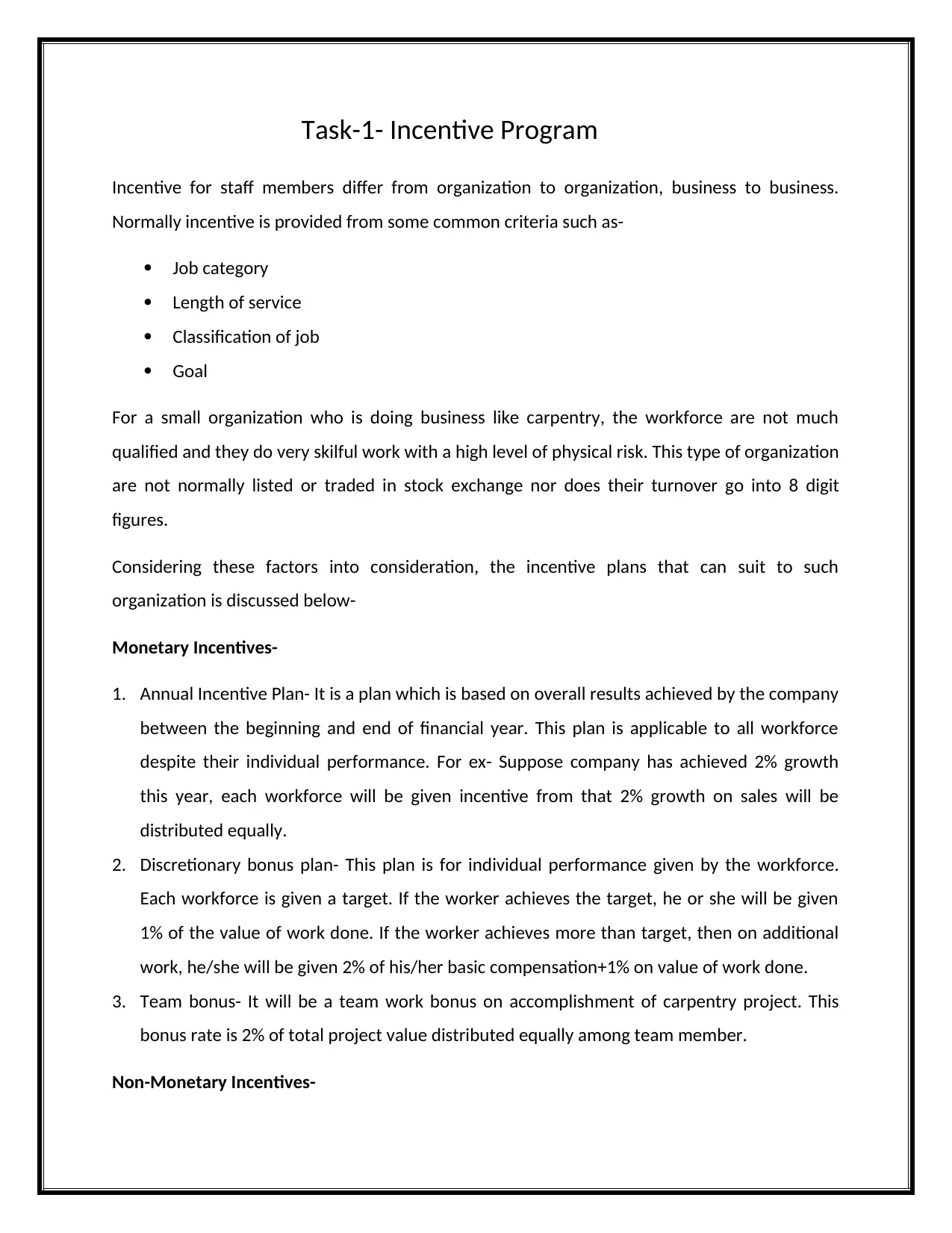
Task-1- Incentive Program
Incentive for staff members differ from organization to organization, business to business.
Normally incentive is provided from some common criteria such as-
Job category
Length of service
Classification of job
Goal
For a small organization who is doing business like carpentry, the workforce are not much
qualified and they do very skilful work with a high level of physical risk. This type of organization
are not normally listed or traded in stock exchange nor does their turnover go into 8 digit
figures.
Considering these factors into consideration, the incentive plans that can suit to such
organization is discussed below-
Monetary Incentives-
1. Annual Incentive Plan- It is a plan which is based on overall results achieved by the company
between the beginning and end of financial year. This plan is applicable to all workforce
despite their individual performance. For ex- Suppose company has achieved 2% growth
this year, each workforce will be given incentive from that 2% growth on sales will be
distributed equally.
2. Discretionary bonus plan- This plan is for individual performance given by the workforce.
Each workforce is given a target. If the worker achieves the target, he or she will be given
1% of the value of work done. If the worker achieves more than target, then on additional
work, he/she will be given 2% of his/her basic compensation+1% on value of work done.
3. Team bonus- It will be a team work bonus on accomplishment of carpentry project. This
bonus rate is 2% of total project value distributed equally among team member.
Non-Monetary Incentives-
Incentive for staff members differ from organization to organization, business to business.
Normally incentive is provided from some common criteria such as-
Job category
Length of service
Classification of job
Goal
For a small organization who is doing business like carpentry, the workforce are not much
qualified and they do very skilful work with a high level of physical risk. This type of organization
are not normally listed or traded in stock exchange nor does their turnover go into 8 digit
figures.
Considering these factors into consideration, the incentive plans that can suit to such
organization is discussed below-
Monetary Incentives-
1. Annual Incentive Plan- It is a plan which is based on overall results achieved by the company
between the beginning and end of financial year. This plan is applicable to all workforce
despite their individual performance. For ex- Suppose company has achieved 2% growth
this year, each workforce will be given incentive from that 2% growth on sales will be
distributed equally.
2. Discretionary bonus plan- This plan is for individual performance given by the workforce.
Each workforce is given a target. If the worker achieves the target, he or she will be given
1% of the value of work done. If the worker achieves more than target, then on additional
work, he/she will be given 2% of his/her basic compensation+1% on value of work done.
3. Team bonus- It will be a team work bonus on accomplishment of carpentry project. This
bonus rate is 2% of total project value distributed equally among team member.
Non-Monetary Incentives-
Paraphrase This Document
Need a fresh take? Get an instant paraphrase of this document with our AI Paraphraser
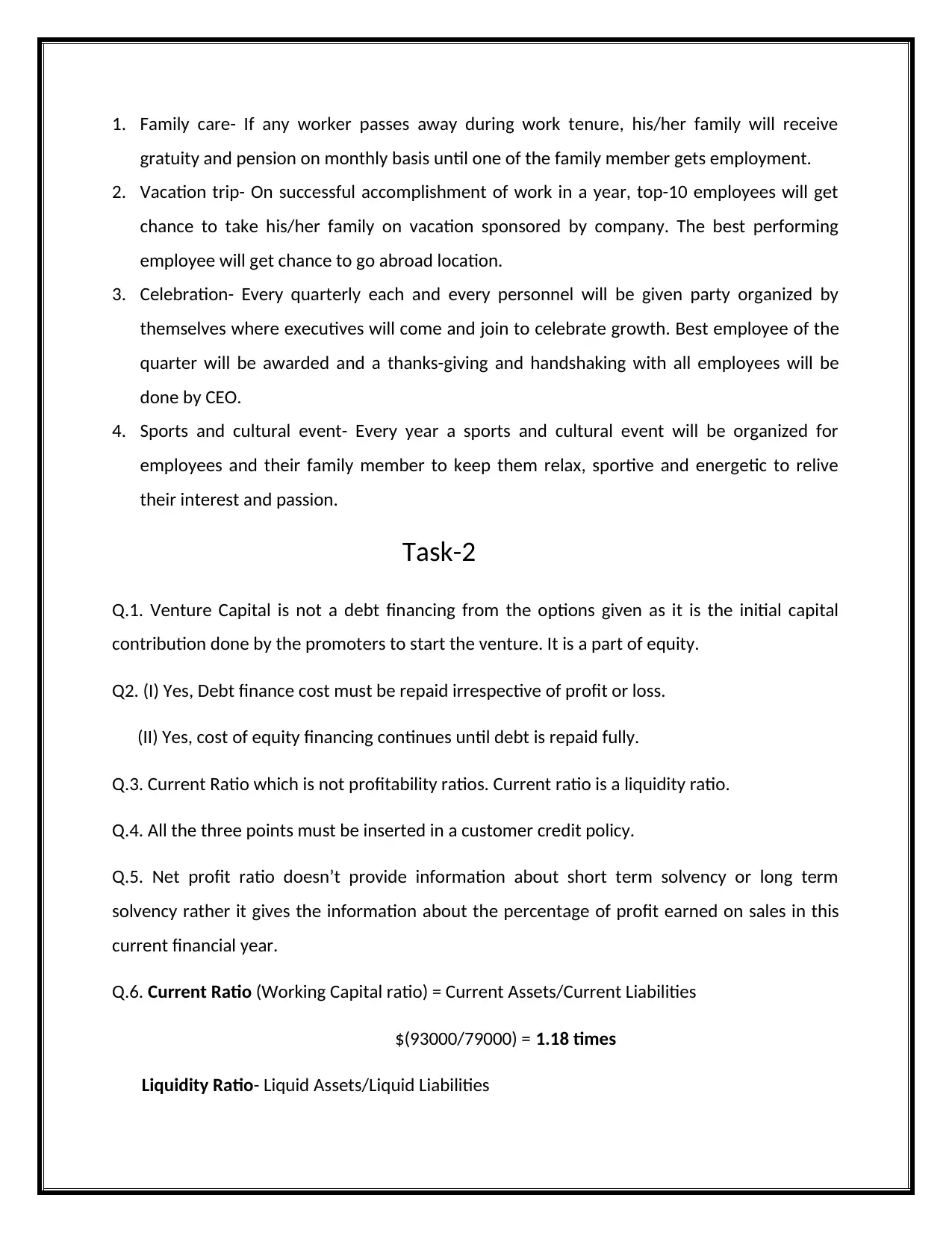
1. Family care- If any worker passes away during work tenure, his/her family will receive
gratuity and pension on monthly basis until one of the family member gets employment.
2. Vacation trip- On successful accomplishment of work in a year, top-10 employees will get
chance to take his/her family on vacation sponsored by company. The best performing
employee will get chance to go abroad location.
3. Celebration- Every quarterly each and every personnel will be given party organized by
themselves where executives will come and join to celebrate growth. Best employee of the
quarter will be awarded and a thanks-giving and handshaking with all employees will be
done by CEO.
4. Sports and cultural event- Every year a sports and cultural event will be organized for
employees and their family member to keep them relax, sportive and energetic to relive
their interest and passion.
Task-2
Q.1. Venture Capital is not a debt financing from the options given as it is the initial capital
contribution done by the promoters to start the venture. It is a part of equity.
Q2. (I) Yes, Debt finance cost must be repaid irrespective of profit or loss.
(II) Yes, cost of equity financing continues until debt is repaid fully.
Q.3. Current Ratio which is not profitability ratios. Current ratio is a liquidity ratio.
Q.4. All the three points must be inserted in a customer credit policy.
Q.5. Net profit ratio doesn’t provide information about short term solvency or long term
solvency rather it gives the information about the percentage of profit earned on sales in this
current financial year.
Q.6. Current Ratio (Working Capital ratio) = Current Assets/Current Liabilities
$(93000/79000) = 1.18 times
Liquidity Ratio- Liquid Assets/Liquid Liabilities
gratuity and pension on monthly basis until one of the family member gets employment.
2. Vacation trip- On successful accomplishment of work in a year, top-10 employees will get
chance to take his/her family on vacation sponsored by company. The best performing
employee will get chance to go abroad location.
3. Celebration- Every quarterly each and every personnel will be given party organized by
themselves where executives will come and join to celebrate growth. Best employee of the
quarter will be awarded and a thanks-giving and handshaking with all employees will be
done by CEO.
4. Sports and cultural event- Every year a sports and cultural event will be organized for
employees and their family member to keep them relax, sportive and energetic to relive
their interest and passion.
Task-2
Q.1. Venture Capital is not a debt financing from the options given as it is the initial capital
contribution done by the promoters to start the venture. It is a part of equity.
Q2. (I) Yes, Debt finance cost must be repaid irrespective of profit or loss.
(II) Yes, cost of equity financing continues until debt is repaid fully.
Q.3. Current Ratio which is not profitability ratios. Current ratio is a liquidity ratio.
Q.4. All the three points must be inserted in a customer credit policy.
Q.5. Net profit ratio doesn’t provide information about short term solvency or long term
solvency rather it gives the information about the percentage of profit earned on sales in this
current financial year.
Q.6. Current Ratio (Working Capital ratio) = Current Assets/Current Liabilities
$(93000/79000) = 1.18 times
Liquidity Ratio- Liquid Assets/Liquid Liabilities
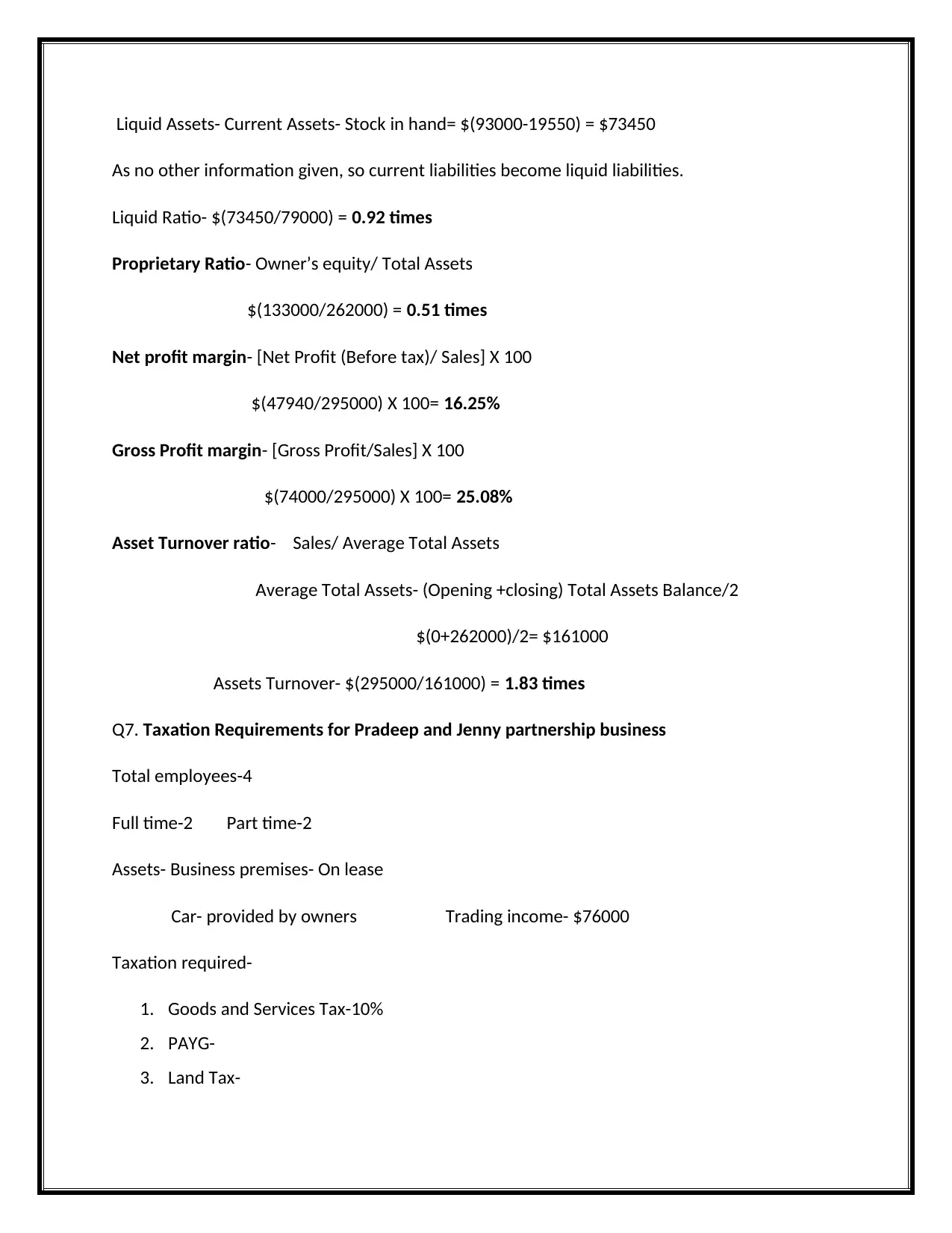
Liquid Assets- Current Assets- Stock in hand= $(93000-19550) = $73450
As no other information given, so current liabilities become liquid liabilities.
Liquid Ratio- $(73450/79000) = 0.92 times
Proprietary Ratio- Owner’s equity/ Total Assets
$(133000/262000) = 0.51 times
Net profit margin- [Net Profit (Before tax)/ Sales] X 100
$(47940/295000) X 100= 16.25%
Gross Profit margin- [Gross Profit/Sales] X 100
$(74000/295000) X 100= 25.08%
Asset Turnover ratio- Sales/ Average Total Assets
Average Total Assets- (Opening +closing) Total Assets Balance/2
$(0+262000)/2= $161000
Assets Turnover- $(295000/161000) = 1.83 times
Q7. Taxation Requirements for Pradeep and Jenny partnership business
Total employees-4
Full time-2 Part time-2
Assets- Business premises- On lease
Car- provided by owners Trading income- $76000
Taxation required-
1. Goods and Services Tax-10%
2. PAYG-
3. Land Tax-
As no other information given, so current liabilities become liquid liabilities.
Liquid Ratio- $(73450/79000) = 0.92 times
Proprietary Ratio- Owner’s equity/ Total Assets
$(133000/262000) = 0.51 times
Net profit margin- [Net Profit (Before tax)/ Sales] X 100
$(47940/295000) X 100= 16.25%
Gross Profit margin- [Gross Profit/Sales] X 100
$(74000/295000) X 100= 25.08%
Asset Turnover ratio- Sales/ Average Total Assets
Average Total Assets- (Opening +closing) Total Assets Balance/2
$(0+262000)/2= $161000
Assets Turnover- $(295000/161000) = 1.83 times
Q7. Taxation Requirements for Pradeep and Jenny partnership business
Total employees-4
Full time-2 Part time-2
Assets- Business premises- On lease
Car- provided by owners Trading income- $76000
Taxation required-
1. Goods and Services Tax-10%
2. PAYG-
3. Land Tax-
⊘ This is a preview!⊘
Do you want full access?
Subscribe today to unlock all pages.

Trusted by 1+ million students worldwide
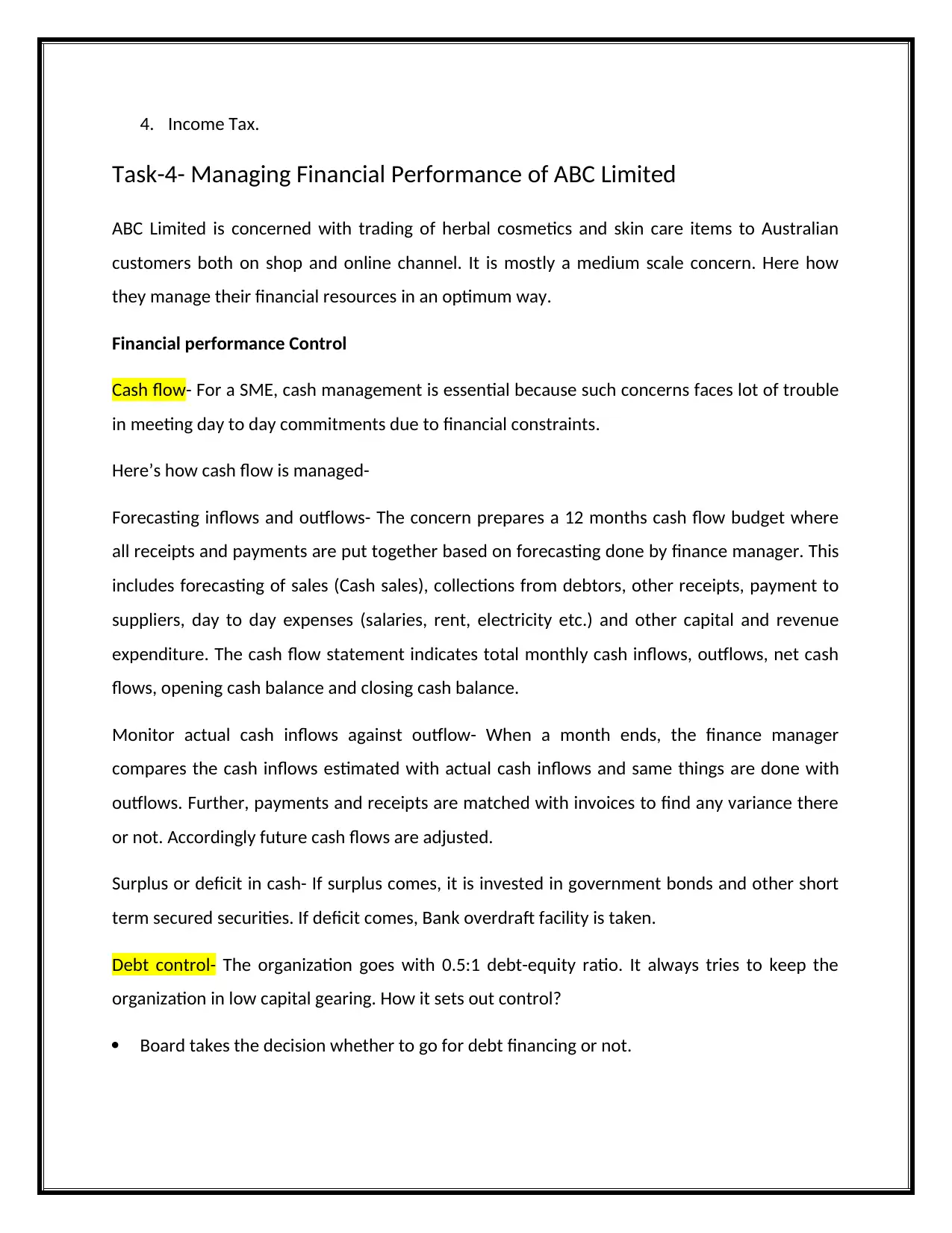
4. Income Tax.
Task-4- Managing Financial Performance of ABC Limited
ABC Limited is concerned with trading of herbal cosmetics and skin care items to Australian
customers both on shop and online channel. It is mostly a medium scale concern. Here how
they manage their financial resources in an optimum way.
Financial performance Control
Cash flow- For a SME, cash management is essential because such concerns faces lot of trouble
in meeting day to day commitments due to financial constraints.
Here’s how cash flow is managed-
Forecasting inflows and outflows- The concern prepares a 12 months cash flow budget where
all receipts and payments are put together based on forecasting done by finance manager. This
includes forecasting of sales (Cash sales), collections from debtors, other receipts, payment to
suppliers, day to day expenses (salaries, rent, electricity etc.) and other capital and revenue
expenditure. The cash flow statement indicates total monthly cash inflows, outflows, net cash
flows, opening cash balance and closing cash balance.
Monitor actual cash inflows against outflow- When a month ends, the finance manager
compares the cash inflows estimated with actual cash inflows and same things are done with
outflows. Further, payments and receipts are matched with invoices to find any variance there
or not. Accordingly future cash flows are adjusted.
Surplus or deficit in cash- If surplus comes, it is invested in government bonds and other short
term secured securities. If deficit comes, Bank overdraft facility is taken.
Debt control- The organization goes with 0.5:1 debt-equity ratio. It always tries to keep the
organization in low capital gearing. How it sets out control?
Board takes the decision whether to go for debt financing or not.
Task-4- Managing Financial Performance of ABC Limited
ABC Limited is concerned with trading of herbal cosmetics and skin care items to Australian
customers both on shop and online channel. It is mostly a medium scale concern. Here how
they manage their financial resources in an optimum way.
Financial performance Control
Cash flow- For a SME, cash management is essential because such concerns faces lot of trouble
in meeting day to day commitments due to financial constraints.
Here’s how cash flow is managed-
Forecasting inflows and outflows- The concern prepares a 12 months cash flow budget where
all receipts and payments are put together based on forecasting done by finance manager. This
includes forecasting of sales (Cash sales), collections from debtors, other receipts, payment to
suppliers, day to day expenses (salaries, rent, electricity etc.) and other capital and revenue
expenditure. The cash flow statement indicates total monthly cash inflows, outflows, net cash
flows, opening cash balance and closing cash balance.
Monitor actual cash inflows against outflow- When a month ends, the finance manager
compares the cash inflows estimated with actual cash inflows and same things are done with
outflows. Further, payments and receipts are matched with invoices to find any variance there
or not. Accordingly future cash flows are adjusted.
Surplus or deficit in cash- If surplus comes, it is invested in government bonds and other short
term secured securities. If deficit comes, Bank overdraft facility is taken.
Debt control- The organization goes with 0.5:1 debt-equity ratio. It always tries to keep the
organization in low capital gearing. How it sets out control?
Board takes the decision whether to go for debt financing or not.
Paraphrase This Document
Need a fresh take? Get an instant paraphrase of this document with our AI Paraphraser
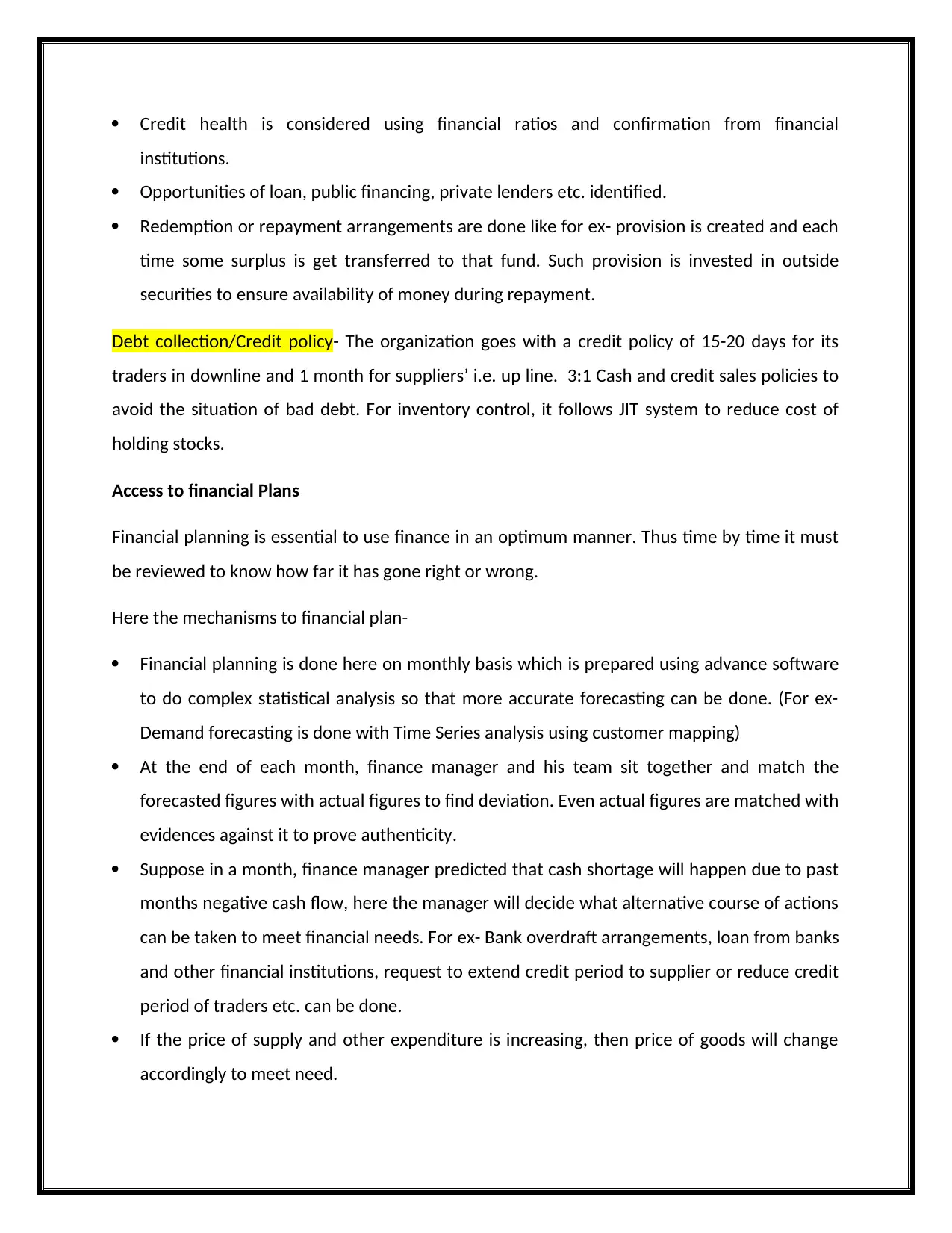
Credit health is considered using financial ratios and confirmation from financial
institutions.
Opportunities of loan, public financing, private lenders etc. identified.
Redemption or repayment arrangements are done like for ex- provision is created and each
time some surplus is get transferred to that fund. Such provision is invested in outside
securities to ensure availability of money during repayment.
Debt collection/Credit policy- The organization goes with a credit policy of 15-20 days for its
traders in downline and 1 month for suppliers’ i.e. up line. 3:1 Cash and credit sales policies to
avoid the situation of bad debt. For inventory control, it follows JIT system to reduce cost of
holding stocks.
Access to financial Plans
Financial planning is essential to use finance in an optimum manner. Thus time by time it must
be reviewed to know how far it has gone right or wrong.
Here the mechanisms to financial plan-
Financial planning is done here on monthly basis which is prepared using advance software
to do complex statistical analysis so that more accurate forecasting can be done. (For ex-
Demand forecasting is done with Time Series analysis using customer mapping)
At the end of each month, finance manager and his team sit together and match the
forecasted figures with actual figures to find deviation. Even actual figures are matched with
evidences against it to prove authenticity.
Suppose in a month, finance manager predicted that cash shortage will happen due to past
months negative cash flow, here the manager will decide what alternative course of actions
can be taken to meet financial needs. For ex- Bank overdraft arrangements, loan from banks
and other financial institutions, request to extend credit period to supplier or reduce credit
period of traders etc. can be done.
If the price of supply and other expenditure is increasing, then price of goods will change
accordingly to meet need.
institutions.
Opportunities of loan, public financing, private lenders etc. identified.
Redemption or repayment arrangements are done like for ex- provision is created and each
time some surplus is get transferred to that fund. Such provision is invested in outside
securities to ensure availability of money during repayment.
Debt collection/Credit policy- The organization goes with a credit policy of 15-20 days for its
traders in downline and 1 month for suppliers’ i.e. up line. 3:1 Cash and credit sales policies to
avoid the situation of bad debt. For inventory control, it follows JIT system to reduce cost of
holding stocks.
Access to financial Plans
Financial planning is essential to use finance in an optimum manner. Thus time by time it must
be reviewed to know how far it has gone right or wrong.
Here the mechanisms to financial plan-
Financial planning is done here on monthly basis which is prepared using advance software
to do complex statistical analysis so that more accurate forecasting can be done. (For ex-
Demand forecasting is done with Time Series analysis using customer mapping)
At the end of each month, finance manager and his team sit together and match the
forecasted figures with actual figures to find deviation. Even actual figures are matched with
evidences against it to prove authenticity.
Suppose in a month, finance manager predicted that cash shortage will happen due to past
months negative cash flow, here the manager will decide what alternative course of actions
can be taken to meet financial needs. For ex- Bank overdraft arrangements, loan from banks
and other financial institutions, request to extend credit period to supplier or reduce credit
period of traders etc. can be done.
If the price of supply and other expenditure is increasing, then price of goods will change
accordingly to meet need.
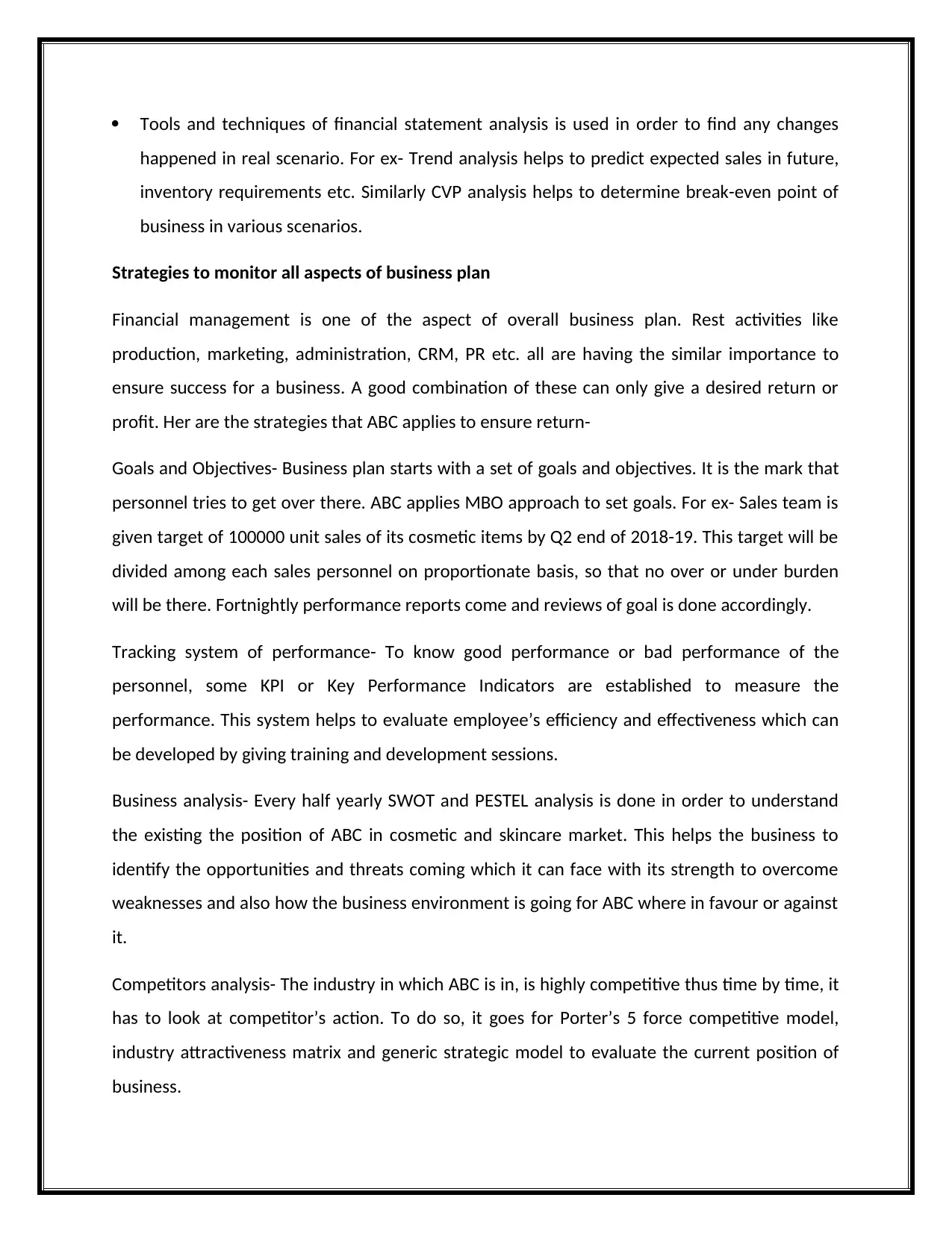
Tools and techniques of financial statement analysis is used in order to find any changes
happened in real scenario. For ex- Trend analysis helps to predict expected sales in future,
inventory requirements etc. Similarly CVP analysis helps to determine break-even point of
business in various scenarios.
Strategies to monitor all aspects of business plan
Financial management is one of the aspect of overall business plan. Rest activities like
production, marketing, administration, CRM, PR etc. all are having the similar importance to
ensure success for a business. A good combination of these can only give a desired return or
profit. Her are the strategies that ABC applies to ensure return-
Goals and Objectives- Business plan starts with a set of goals and objectives. It is the mark that
personnel tries to get over there. ABC applies MBO approach to set goals. For ex- Sales team is
given target of 100000 unit sales of its cosmetic items by Q2 end of 2018-19. This target will be
divided among each sales personnel on proportionate basis, so that no over or under burden
will be there. Fortnightly performance reports come and reviews of goal is done accordingly.
Tracking system of performance- To know good performance or bad performance of the
personnel, some KPI or Key Performance Indicators are established to measure the
performance. This system helps to evaluate employee’s efficiency and effectiveness which can
be developed by giving training and development sessions.
Business analysis- Every half yearly SWOT and PESTEL analysis is done in order to understand
the existing the position of ABC in cosmetic and skincare market. This helps the business to
identify the opportunities and threats coming which it can face with its strength to overcome
weaknesses and also how the business environment is going for ABC where in favour or against
it.
Competitors analysis- The industry in which ABC is in, is highly competitive thus time by time, it
has to look at competitor’s action. To do so, it goes for Porter’s 5 force competitive model,
industry attractiveness matrix and generic strategic model to evaluate the current position of
business.
happened in real scenario. For ex- Trend analysis helps to predict expected sales in future,
inventory requirements etc. Similarly CVP analysis helps to determine break-even point of
business in various scenarios.
Strategies to monitor all aspects of business plan
Financial management is one of the aspect of overall business plan. Rest activities like
production, marketing, administration, CRM, PR etc. all are having the similar importance to
ensure success for a business. A good combination of these can only give a desired return or
profit. Her are the strategies that ABC applies to ensure return-
Goals and Objectives- Business plan starts with a set of goals and objectives. It is the mark that
personnel tries to get over there. ABC applies MBO approach to set goals. For ex- Sales team is
given target of 100000 unit sales of its cosmetic items by Q2 end of 2018-19. This target will be
divided among each sales personnel on proportionate basis, so that no over or under burden
will be there. Fortnightly performance reports come and reviews of goal is done accordingly.
Tracking system of performance- To know good performance or bad performance of the
personnel, some KPI or Key Performance Indicators are established to measure the
performance. This system helps to evaluate employee’s efficiency and effectiveness which can
be developed by giving training and development sessions.
Business analysis- Every half yearly SWOT and PESTEL analysis is done in order to understand
the existing the position of ABC in cosmetic and skincare market. This helps the business to
identify the opportunities and threats coming which it can face with its strength to overcome
weaknesses and also how the business environment is going for ABC where in favour or against
it.
Competitors analysis- The industry in which ABC is in, is highly competitive thus time by time, it
has to look at competitor’s action. To do so, it goes for Porter’s 5 force competitive model,
industry attractiveness matrix and generic strategic model to evaluate the current position of
business.
⊘ This is a preview!⊘
Do you want full access?
Subscribe today to unlock all pages.

Trusted by 1+ million students worldwide
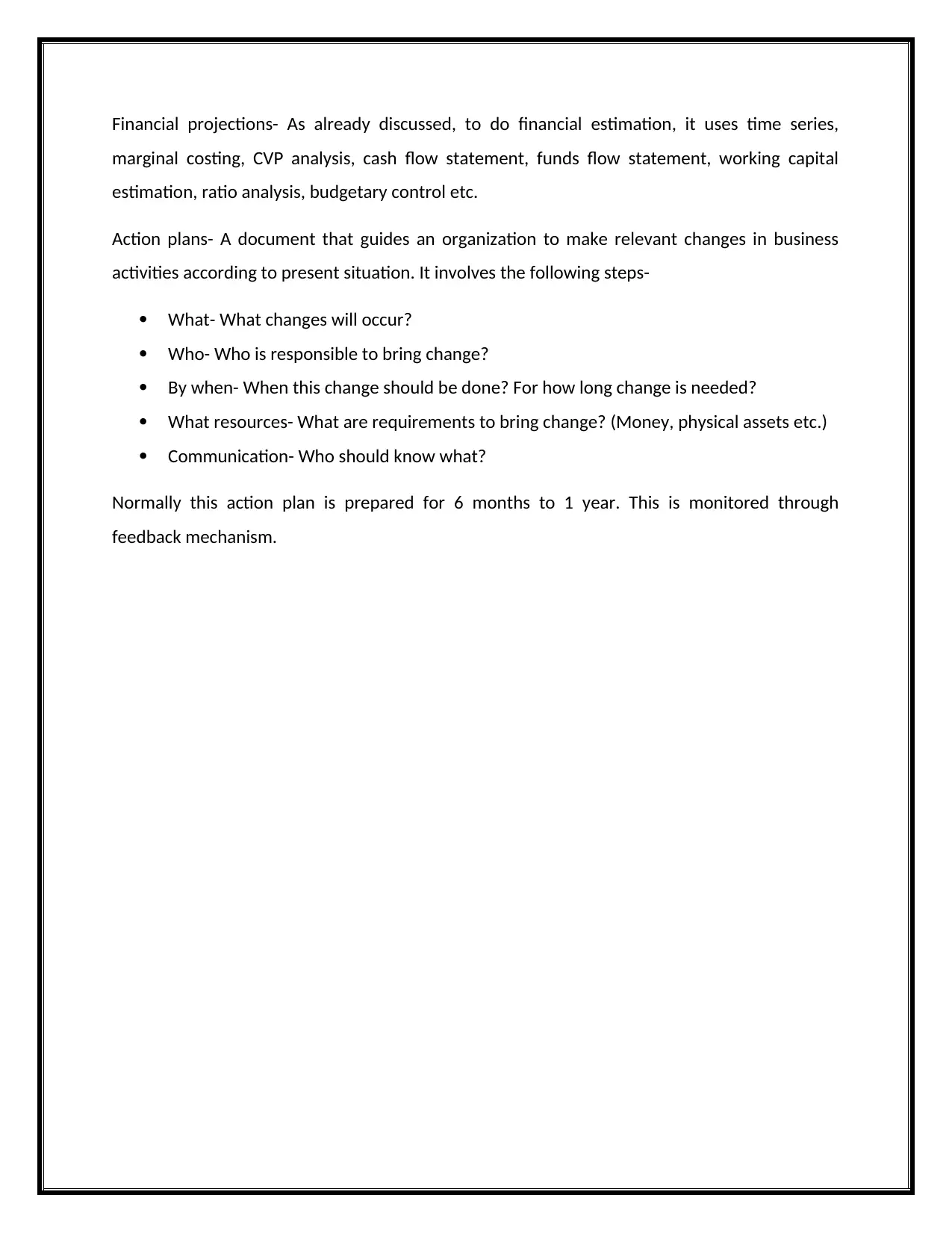
Financial projections- As already discussed, to do financial estimation, it uses time series,
marginal costing, CVP analysis, cash flow statement, funds flow statement, working capital
estimation, ratio analysis, budgetary control etc.
Action plans- A document that guides an organization to make relevant changes in business
activities according to present situation. It involves the following steps-
What- What changes will occur?
Who- Who is responsible to bring change?
By when- When this change should be done? For how long change is needed?
What resources- What are requirements to bring change? (Money, physical assets etc.)
Communication- Who should know what?
Normally this action plan is prepared for 6 months to 1 year. This is monitored through
feedback mechanism.
marginal costing, CVP analysis, cash flow statement, funds flow statement, working capital
estimation, ratio analysis, budgetary control etc.
Action plans- A document that guides an organization to make relevant changes in business
activities according to present situation. It involves the following steps-
What- What changes will occur?
Who- Who is responsible to bring change?
By when- When this change should be done? For how long change is needed?
What resources- What are requirements to bring change? (Money, physical assets etc.)
Communication- Who should know what?
Normally this action plan is prepared for 6 months to 1 year. This is monitored through
feedback mechanism.
1 out of 7
Your All-in-One AI-Powered Toolkit for Academic Success.
+13062052269
info@desklib.com
Available 24*7 on WhatsApp / Email
![[object Object]](/_next/static/media/star-bottom.7253800d.svg)
Unlock your academic potential
Copyright © 2020–2025 A2Z Services. All Rights Reserved. Developed and managed by ZUCOL.
